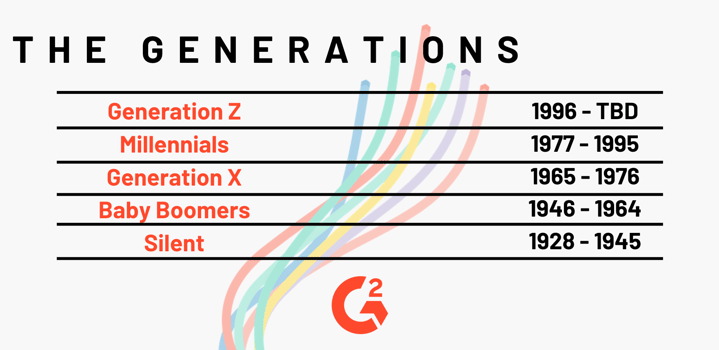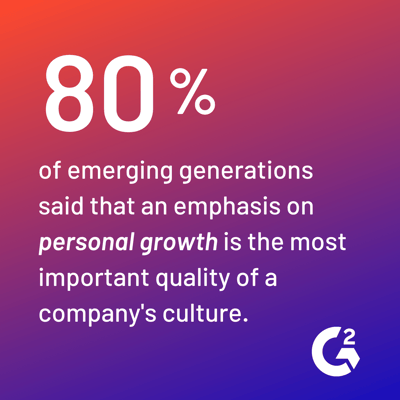Some of you reading this may be surprised by the fact I’m about to share:
I was born in 1995. I can already feel a few of you cringing at this number.
You see, I straddle the line between two incredibly important generations: Millennials and Gen Z. You’ve likely heard quite a bit about Millennials (the generation responsible for “killing” all sorts of industries), but may not be as familiar with Gen Z.
Generational differences are the biggest diversity factor for a company, often causing the most tension in the workplace. Currently, the largest portion of the workforce is composed of Millennials, and by 2025, Millennials and Gen Z will make up an incredible majority of employees.

The reality is, understanding both of these generations is increasingly important to building a successful workforce for your company. If you’re a recruiter, then it’s crucial to know exactly what drives Millennials and Gen Z to join–and stick with–a company.
Let’s dive in and figure out exactly who these groups are and what recruitment strategies you need in order to get the job done.
Recruiting Millennials and Gen Z
The most important thing to keep in mind when discussing emerging generations is that generations are clues, they’re not absolutes.
Knowing what generation a person is from can provide some information on their behavior and preferences, but it’s not a complete indication of character. In fact, there’s even an incredible amount of differences between the two generations.
What’s the difference between Millennials and Gen Z?
It’s best to lay a foundation for the people who make up these groups. Keep in mind, there’s no exact science to this. People born in 1995 may connect more with Gen Z values than Millennial values or vice versa. As stated earlier, it’s not absolute.

These generations have specific values and behaviors shaped by the world they were born into. These values can greatly affect views on work and business.
For example, Gen Z is naturally more cautious when it comes to joining a company. Roughly 70% of Gen Z-ers might reject traditional businesses to work independently. They’ve grown up in a society where it’s never been sexier to be an entrepreneur. Companies no longer just compete with each other, they compete with entrepreneurship. This contrasts with Millennials who prefer collaborative work and are more likely to be formally educated. Millennials want a better boss, a bigger vision, and a brighter future.
If you take the time to understand the motivations and values of emerging generations, you can make it easier on yourself to recruit them. The three following strategies are at the forefront of attracting, engaging, and keeping Millennial and Gen Z talent.

More than your average newsletter.
Every Thursday, we spill hot takes, insider knowledge, and news recaps straight to your inbox. Subscribe here
3 Strategies to recruit Millennials and Gen Z
These strategies, influenced by Ryan Jenkins of Inc. Magazine, are the best ways to recruit and retain a Millennial and Gen Z workforce at your company. The expectations of these generations may seem high, but companies who rise to the challenge of making recruitment and employment seamless and effortless are the ones that will succeed.
1. Optimize communication
All generations have varying communication preferences. For a Boomer, sending a letter or making a call was often the first touch point in the recruitment process. Millennials and Gen Z know better and will typically do thorough internet research before even contacting a company. It’s important for recruiters to use videos and other multimedia in order to let these candidates visualize themselves at these companies.
| Hot Take: In an untethered world, younger generations are choosing a city before a job, so showcasing the community your company is in (and how the organization contributes to the community) matters as much showcasing your company. |
When doing this research, emerging generations want to know the culture and values, perks and benefits, and employee perspectives. That’s because the top obstacle that prevents these candidates from joining a company is not knowing what the organization is like. Even if you have great content to share, it’s important to place it right in front of your audience.
Gen Z and Millennials are looking for this information on two key places: YouTube and Instagram. If you’re not using these channels to promote what it’s like to work for your company, you’re already behind. Increased engagement is just one of many reasons why your business should be on YouTube.
Take a look at SAP and what it's doing with its lifeatsap YouTube channel.
By providing employee testimonials and showing off exactly what life is like to work for their company, prospective employees are able to visualize themselves in the same position more easily. These employees also testify about how the company contributes to this next strategy of providing learning and development.
2. Provide learning and development
Just as each generation has varying preferences on communication, they also have major differences in learning and development preferences. In fact, the #1 factor Millennials consider when starting a new job is whether there is sufficient training. Emerging generations want to be with a company that invests in them and their skills.
 Learning and development is why emerging generations take a job and stay there, so you need to ensure that your company is doing everything in its power to provide this for its employees.
Learning and development is why emerging generations take a job and stay there, so you need to ensure that your company is doing everything in its power to provide this for its employees.
| Related: Younger generations value diversity in the workplace. Learn how to optimize your job ads to attract the most qualified candidates for the job. |
When creating a culture of learning at your company consider the communication preferences of the emerging generations as well. Learning opportunities should be optimized through micro-learning. Do this by providing 5 to 15 minute on-demand videos with clean design and including blended trainings.
An employee who is immersed in a culture of learning and feels valued contributes additionally to the third strategy of enhancing the employee experience.
3. Enhance the employee experience
Any company’s goal for its employees’ success should be to create an organization that people want, not need, to go to work. These generations have been the most empowered group as consumers and they’ve come to expect this empowerment in their careers.
Much of this empowerment comes from proper recognition. Millennials and Gen Z crave recognition in the workplace for their hard work. This recognition should be visible, widespread, received from peers, and in real time.
Here at G2, we utilize a company-wide Slack channel where anyone can nominate another employee for personifying one of our four core values of Performance, Entrepreneurial Spirit, Authenticity, and Kindness. All of these nominations contribute to our monthly PEAK awards. Each team also has its own awards which are typically given out on a similar basis. Here’s an example of a nomination I received not long ago:
 On top of proper recognition, it’s important that Millennials and Gen Z are managed based on output metrics rather than input. Emerging generations have been highly influenced by the “work smarter, not harder” value. These are two generations that have grown up being told they have a poor work ethic, when in reality, they are just highly under-utilized.
On top of proper recognition, it’s important that Millennials and Gen Z are managed based on output metrics rather than input. Emerging generations have been highly influenced by the “work smarter, not harder” value. These are two generations that have grown up being told they have a poor work ethic, when in reality, they are just highly under-utilized.

There’s nothing to fear
As Millennials and Gen Z grow to be the majority of the workforce, you need to adjust your recruitment and retention tactics to fit. These three strategies can help you attract, engage, and retain talent from emerging generations, but what’s more important is gaining an understanding of who these groups are and what values they have.
The workforce is changing, it’s time your workplace changes too.

 by Jessica Ruane
by Jessica Ruane
 by Alexa Drake
by Alexa Drake
 by Eric Quanstrom
by Eric Quanstrom